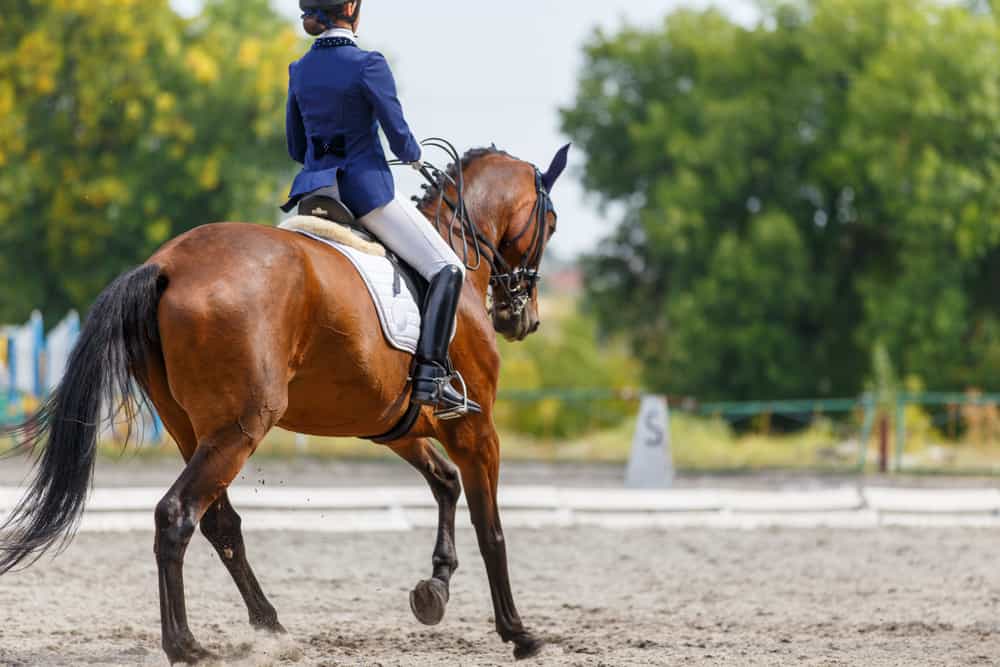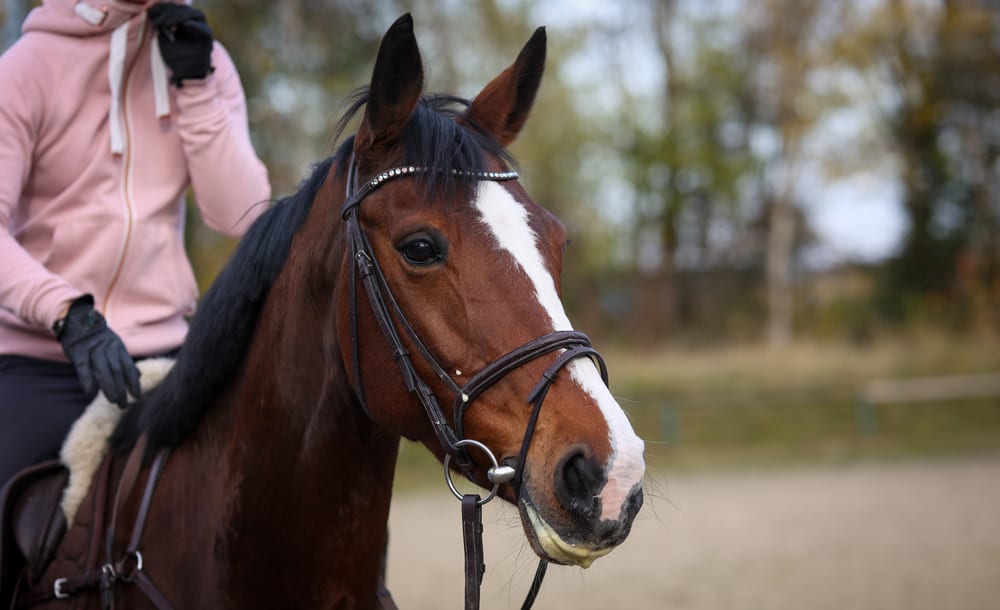- Your source for stall mats, rubber arena footing, arena harrows and arena dust control.

There are so many different rules regarding what tack is legal for use in affiliated dressage competitions. And to complicate things further, the rules change again as you progress to the higher levels. With so many variations of tack items available these days, it can get a little confusing. Nosebands are a great example of this, as there are numerous different types and styles from which to choose.
You can do dressage in a grackle noseband, albeit only in the lower levels, and only where the use of a snaffle bit is required. In higher-level dressage, and while using a double bridle, just a simple cavesson noseband is permitted. Grackle nosebands were not always accepted for use in dressage. They were only legalized by the FEI (International Federation for Equestrian Sports) in 2016 due to amendments to their rules.
The rules regarding the types of tack, including which nosebands are permitted in dressage competitions, are based on the action of each individual item. In other words, what do they do? How do they work? And how do they affect the horse while at work? All of the above factors are considered when deciding which items of tack, nosebands included, are legal for use in dressage.
Why would you use a grackle in dressage?
When riding and training the horse in dressage, there is a need for a connection between the horse’s mouth and the rider’s hands, referred to as the contact. The contact is essentially a line of communication between the horse and rider. Some horses will try to escape or evade the contact by opening their mouths, crossing the lower jaw from one side to the other, pulling excessively hard against the rider’s hands, or yanking roughly against the reins. Some horses do this because they are simply trying to find a way out of working correctly, while other horses do this due to pain, discomfort, or a lack of understanding.
Acceptance of the bit and submission to the rider and their aids are vital parts of training and are marked accordingly during dressage tests in competitions. By trying to escape from the contact, the horse shows neither acceptance nor submission but rather the opposite. By employing certain types of equipment, such as a grackle noseband, if it is suitable for a particular horse, the rider works toward improving the horse’s acceptance of the bit and, therefore, the contact.
Once the horse has accepted the bit and is working correctly into the rider’s contact, there is a more harmonious connection between horse and rider, making communication within the partnership during dressage training more fluid and smooth.
The purpose of the grackle noseband in dressage
The grackle noseband is a variation of the flash noseband (a cavesson noseband with an attachment for the flash strap in the noseband’s front center) and was designed to have a similar action. The design helps spread the pressure evenly and over a larger area of the horses’ face. It also does a little more in the way of discouraging the crossing of the jaw. Due to its higher placement at the front of the face, the grackle noseband also leaves more room around the nostrils than the flash noseband, which means it is less restrictive, making breathing easier for the horse.
The purpose of a grackle noseband is to help the horse and rider achieve and maintain better contact, especially with a horse who inclines to make attempts at evading the rider’s hands (by way of escaping the action of the bit). The grackle noseband should help the horse accept the contact and learn and understand what behaviors (such as crossing the jaw and opening the mouth) are not acceptable.
The grackle noseband was initially designed in 1931 for a Thoroughbred (named Grackle) who would pull excessively hard against the jockey during a race to give the jockey an extra measure of control. And this is where it got its name.
How does a grackle noseband work?
For a grackle noseband to work correctly, it needs to fit the horse precisely. If you are using one for the first time or are unsure of the fit, it would be wise to ask an experienced person to help. The top strap of the noseband fastens just below the horse’s cheeks, much higher than a regular cavesson noseband, thereby preventing the horse from crossing its jaw. The lower strap, which fastens below the bit in the same position as a flash, keeps the horse’s mouth closed and provides stability for the bit.
The figure-eight design of the grackle noseband changes the location where pressure is applied, much higher than a regular flash noseband, on the more boney area of the face. Some horses might prefer this and find it more comfortable.
How to fit a grackle noseband
If the grackle noseband is either too tight or too loose, it will not work correctly. To check if it is the correct tightness, you should be able to comfortably fit one or two fingers between the noseband straps and the face, all the way around. The central part of the noseband where the two straps meet and cross over the front of the face should sit precisely in the center, the top strap fastening just below the cheekbones, and the lower strap fastening in the chin groove, below the bit.
In other words, to have the proper action, the grackle noseband must be tight enough that when the horse opens his mouth or tries to cross his jaw, the noseband should apply pressure, therefore restricting this evasive action by the horse. It also needs to be loose enough that the pressure is released when the horse relaxes its jaw.
It is easy to over-tighten a grackle noseband. By doing so, you will hurt the horse and therefore not achieve its trust, which makes achieving the comfortable and relaxed contact necessary for dressage impossible. You will create an uncomfortable and tense horse that is doing all it can to avoid pain and discomfort caused by the equipment. In this case, the grackle noseband will work against you rather than for you.

Can you use a grackle noseband in all levels of dressage?
You can only use a grackle noseband dressage if you use a snaffle bit, which means it is limited to use only in the lower-levels. It is illegal to use a grackle noseband with a double bridle (a bridle with two bits) or with any bit with a curb-chain, as it will interfere with the proper action of these bits. It can also cause considerable discomfort in the horse’s mouth.
If the grackle noseband (or any noseband for that matter) has not been fitted correctly or is excessively tight, it will not be permitted for use in a dressage competition, and the rider could be eliminated. The Steward who is present at a competition will check the tack as the horse leaves the competition arena and ensure it fits correctly and that it is not too tight. If the Steward finds that the noseband is fastened too tight, he will report you to the judge.
Conclusion
Tack and equipment, nosebands included, are supposed to help the rider get the best out of their horse and training. When used correctly, tack does not restrict or cause any discomfort to the horse. Instead, it helps them better understand what is expected of them and create a constructive and relaxed training environment.
Gadgets and fancy equipment do not make up for a lack of knowledge and experience. If you feel the need to turn to stronger gear, before you do so, consult an experienced trainer and ask for their advice. There might be an easy solution. Tack is not there to force the horse into submission, as only through relaxation and trust will you achieve true acceptance from the horse.

